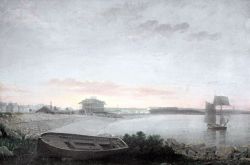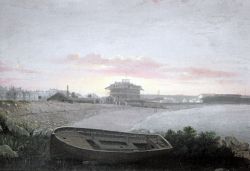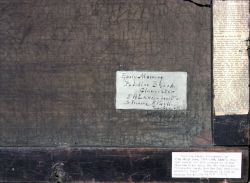loading 
Fitz Henry Lane
HISTORICAL ARCHIVE • CATALOGUE RAISONNÉ • EDUCATIONAL RESOURCE
An online project under the direction of the CAPE ANN MUSEUM
An online project under the direction of the CAPE ANN MUSEUM
Catalog entry
inv. 78
Early Morning, Pavilion Beach, Gloucester
Pavilion Beach, Gloucester
c. 1850–55 Oil on canvas relined 14 x 20 1/4 in. (35.6 x 51.4 cm) Inscribed verso: Early Morning / Pavilion Beach / Gloucester / F.H. Lane fecit / D. Jerome Elwell / touched it / March 13, 91 (before relining)
|
Related Work in the Catalog
Supplementary Images
Provenance (Information known to date; research ongoing.)
Bertram K. and Nina Fletcher Little, Brookline, Massachusetts, by 1964
Estate of Nina Fletcher Little
Northeast Auctions, Portsmouth, New Hampshire
Hirschl & Adler Galleries, New York
William S. Shanahan, Darien, Connecticut
Exhibition History
DeCordova Museum, Lincoln, Massachusetts, Fitz Hugh Lane: The First Major Exhibition, March 20–April 17, 1966., no. 13, Early Morning, Pavilion Beach, Gloucester.
Traveled to: Colby College Art Museum, Waterville, Maine, 30–6, 1966.
Traveled to: Colby College Art Museum, Waterville, Maine, 30–6, 1966.
Vero Beach Museum of Art, Vero Beach, Florida, Ships and Shorelines: William Bradford and Nineteenth-Century American Marine Painting, January 30–May 30, 2010.
Published References
Wilmerding, John. Fitz Hugh Lane, 1804–1865: American Marine Painter. Salem, MA: The Essex Institute, 1964., no. 33, p. 56.
The American Neptune, Pictorial Supplement VII: A Selection of Marine Paintings by Fitz Hugh Lane, 1804–1865. Salem, MA: The American Neptune, 1965., pl. XI, no. 33. ⇒ includes  text
text
Wilmerding, John. Fitz Hugh Lane: The First Major Exhibition. Lincoln, MA: De Cordova Museum; in association with Colby College Art Museum, 1966., no. 13. ⇒ includes  text
text



Commentary
Looking due east from the Cut, the Pavilion Hotel is silhouetted by the sun rising directly beyond it. A lovely summer dawn spreads across the harbor. The painting’s narrow angle of view leaves all of Gloucester’s church spires out of sight, beyond the left margin. It also serves to emphasize the extent of Fort Point’s rocky southwestern end, which extends nearly to the right margin, with Rocky Neck in the background. A few vessels are in the background, some painted as drawn in Lane’s sketch – all serving to give a better idea of scale and size of distant objects and their surroundings. On the verso is an inscription, visible before relining, "D. Jerome Elwell touched it, March 13 '91." Interestingly, this is the same inscription as on the verso of Early Morning, Pavilion Beach, Gloucester, c.1850–55 (inv. 78). Jerome Elwell was purported to have been a student of Lane for a short time when Elwell was very young; he must have had access to both of these paintings via Joseph Stevens Jr. and was allowed to "touch" them on that date. Both paintings have been cleaned and there don't appear to be any remnants of what Elwell did, so it was thankfully minor – possibly just brightening the sky colors to suit more modern tastes.
The Pavilion Hotel was built in 1849 and was the first of the tourist hotels built after the railroad from Boston arrived in 1847. The hotel was built on the site of Ignatius Webber’s windmill, which was built in 1814 for grinding corn. Long in disuse, it was moved to George H. Rogers’s new wharf at Fort Point in 1849 where it was used as a storage building. In the great fire of 1877, it partially burned and the remains were torn down. To the right of the windmill, built into the sloped side of Fort Point, is a long building which was Rogers’ first step in building a wharf and storage complex on the point’s eastern and southeastern shoreline. Partially overlapping the Rogers building are the crumbling remains of Fort Defiance.
The angle of view deceptively foreshortens the length of the dark ropewalk building situated above the beach, to the left of the hotel. It runs parallel to, and nearly half the length of Canal Street, with new houses lining the street’s opposite side. What was to become Western Avenue and Stacy Boulevard was only in its beginning stage.
Lane added very little in the way of vessels to this painting. The topsail schooner at far right is a workaday coasting vessel of little distinction. More interesting is the dramatic yawl boat in the foreground – a large example of the type, probably 20 feet long. Intended for sailing more than rowing, it has holes for stepping two masts, one in the fore deck and the other in the rider plank connecting the two thwarts. A ketch rig with two spritsails and no jib was common for this type and period (View of Gloucester, 1859 (inv. 91), foreground). A rudder and tiller are evidenced by the tiller port in the transom and the arc-shaped tiller rack with notches to hold the tiller, allowing the boat to hold its course while the helmsman was busy with other tasks.
While Lane painted sunrise views in other locations, this depiction of Gloucester is unique for its direction of view and viewing point. The geography of Cape Ann and the city’s layout are the likely reasons for this, and it took Lane’s practiced eye and some opportune changes to Gloucester’s skyline to make this composition possible.
–Erik Ronnberg